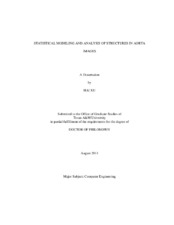| dc.contributor.advisor | Liu, Jyh-Charn | |
| dc.creator | Xu, Hai | |
| dc.date.accessioned | 2012-10-19T15:28:40Z | |
| dc.date.accessioned | 2012-10-22T18:00:04Z | |
| dc.date.available | 2012-10-19T15:28:40Z | |
| dc.date.available | 2012-10-22T18:00:04Z | |
| dc.date.created | 2011-08 | |
| dc.date.issued | 2012-10-19 | |
| dc.date.submitted | August 2011 | |
| dc.identifier.uri | https://hdl.handle.net/1969.1/ETD-TAMU-2011-08-9779 | |
| dc.description.abstract | Morphology change analysis of aorta images acquired from biological experiments plays a critical role in exploring the relationship between lamina thickness (LT), interlamellar distance (ILD) and fragmentation (furcation points) with respect to pathological conditions. An automated software tool now is available to extract elastic laminae (EL) and measure LT, ILD and fragmentation along their ridge lines in a fine detailed aspect. A statistical randomized complete block design (RCBD) and F-test were used to assess potential (non)-uniformity of LT and ILD along both radial and circumferential directions. Illustrative results for both normotensive and hypertensive thoracic porcine aorta revealed marked heterogeneity along the radial direction in nearly stress-free samples. Quantifying furcation point densities were also found that can offer new information about potential elastin fragmentation, particularly in response to increased loading due to hypertension.
Furthermore, when biological scientists analyze the elastic lamina structure, how to automatically generate a macro-level geometric parameter mapping might greatly help them understand the over-all morphology changes of blood vessel cross section. In this dissertation, another automated system is designed to quickly locate more pronounced EL branches to construct layer level abstraction of LT/ILD measurements and transform the sparse pixel level information to dense normalized Virtual Layer Matrix (VLM). The system can automatically compute the EL orientations, identify pronounced ELs, transform the denoised LT measurement points onto a VLM and then provide statistics/segmentation analysis. By applying the k-means segmentation technique to VLMs of LT-ILD, one can easily delineate regions of normal vs. hypertrophic and/or hyperplasia LT-ILD measurements for cross-image references. | en |
| dc.format.mimetype | application/pdf | |
| dc.language.iso | en_US | |
| dc.subject | Vascular Elastin | en |
| dc.subject | Automated Histology | en |
| dc.subject | Quantitative Pathology | en |
| dc.subject | Discrete Radon Transform | en |
| dc.subject | Furcation Point Analysis | en |
| dc.subject | Randomized Complete Block Design | en |
| dc.subject | Virtual Layer Matrix | en |
| dc.subject | K-Means | en |
| dc.subject | Hypertension | en |
| dc.subject | Marfan
Syndrome | en |
| dc.subject | Aging | en |
| dc.title | Structural Modeling and Analysis of Structures in Aorta Images | en |
| dc.type | Thesis | en |
| thesis.degree.department | Computer Science and Engineering | en |
| thesis.degree.discipline | Computer Engineering | en |
| thesis.degree.grantor | Texas A&M University | en |
| thesis.degree.name | Doctor of Philosophy | en |
| thesis.degree.level | Doctoral | en |
| dc.contributor.committeeMember | Humphrey, Jay D. | |
| dc.contributor.committeeMember | Choe, Yoonsuck | |
| dc.contributor.committeeMember | Song, Dezhen | |
| dc.type.genre | thesis | en |
| dc.type.material | text | en |


